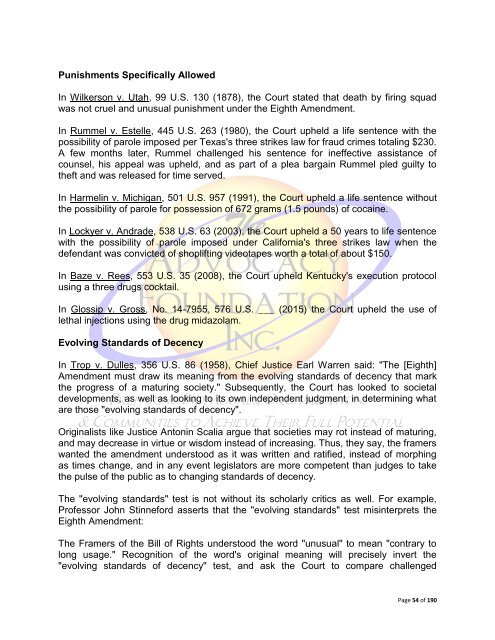The Violent Crime and Law Enforcement Act of 1994
The Violent Crime and Law Enforcement Act of 1994
The Violent Crime and Law Enforcement Act of 1994
Create successful ePaper yourself
Turn your PDF publications into a flip-book with our unique Google optimized e-Paper software.
Punishments Specifically Allowed<br />
In Wilkerson v. Utah, 99 U.S. 130 (1878), the Court stated that death by firing squad<br />
was not cruel <strong>and</strong> unusual punishment under the Eighth Amendment.<br />
In Rummel v. Estelle, 445 U.S. 263 (1980), the Court upheld a life sentence with the<br />
possibility <strong>of</strong> parole imposed per Texas's three strikes law for fraud crimes totaling $230.<br />
A few months later, Rummel challenged his sentence for ineffective assistance <strong>of</strong><br />
counsel, his appeal was upheld, <strong>and</strong> as part <strong>of</strong> a plea bargain Rummel pled guilty to<br />
theft <strong>and</strong> was released for time served.<br />
In Harmelin v. Michigan, 501 U.S. 957 (1991), the Court upheld a life sentence without<br />
the possibility <strong>of</strong> parole for possession <strong>of</strong> 672 grams (1.5 pounds) <strong>of</strong> cocaine.<br />
In Lockyer v. Andrade, 538 U.S. 63 (2003), the Court upheld a 50 years to life sentence<br />
with the possibility <strong>of</strong> parole imposed under California's three strikes law when the<br />
defendant was convicted <strong>of</strong> shoplifting videotapes worth a total <strong>of</strong> about $150.<br />
In Baze v. Rees, 553 U.S. 35 (2008), the Court upheld Kentucky's execution protocol<br />
using a three drugs cocktail.<br />
In Glossip v. Gross, No. 14-7955, 576 U.S. ___ (2015) the Court upheld the use <strong>of</strong><br />
lethal injections using the drug midazolam.<br />
Evolving St<strong>and</strong>ards <strong>of</strong> Decency<br />
In Trop v. Dulles, 356 U.S. 86 (1958), Chief Justice Earl Warren said: "<strong>The</strong> [Eighth]<br />
Amendment must draw its meaning from the evolving st<strong>and</strong>ards <strong>of</strong> decency that mark<br />
the progress <strong>of</strong> a maturing society." Subsequently, the Court has looked to societal<br />
developments, as well as looking to its own independent judgment, in determining what<br />
are those "evolving st<strong>and</strong>ards <strong>of</strong> decency".<br />
Originalists like Justice Antonin Scalia argue that societies may rot instead <strong>of</strong> maturing,<br />
<strong>and</strong> may decrease in virtue or wisdom instead <strong>of</strong> increasing. Thus, they say, the framers<br />
wanted the amendment understood as it was written <strong>and</strong> ratified, instead <strong>of</strong> morphing<br />
as times change, <strong>and</strong> in any event legislators are more competent than judges to take<br />
the pulse <strong>of</strong> the public as to changing st<strong>and</strong>ards <strong>of</strong> decency.<br />
<strong>The</strong> "evolving st<strong>and</strong>ards" test is not without its scholarly critics as well. For example,<br />
Pr<strong>of</strong>essor John Stinneford asserts that the "evolving st<strong>and</strong>ards" test misinterprets the<br />
Eighth Amendment:<br />
<strong>The</strong> Framers <strong>of</strong> the Bill <strong>of</strong> Rights understood the word "unusual" to mean "contrary to<br />
long usage." Recognition <strong>of</strong> the word's original meaning will precisely invert the<br />
"evolving st<strong>and</strong>ards <strong>of</strong> decency" test, <strong>and</strong> ask the Court to compare challenged<br />
Page 54 <strong>of</strong> 190
















